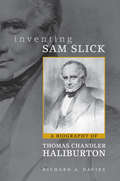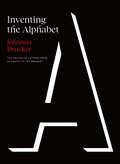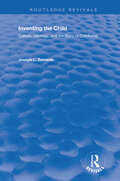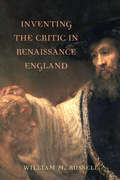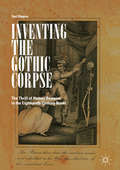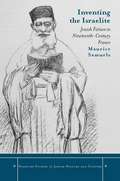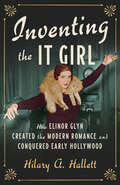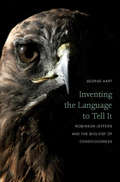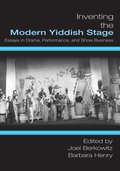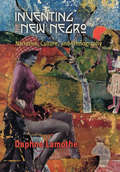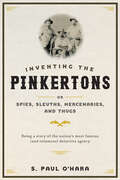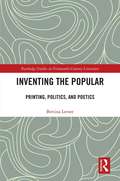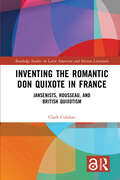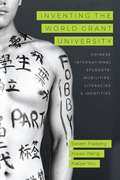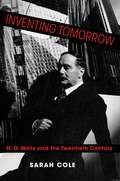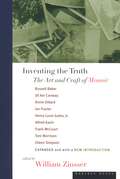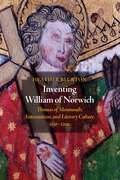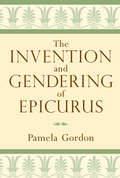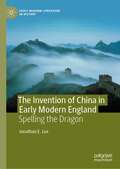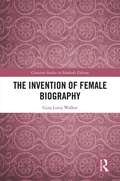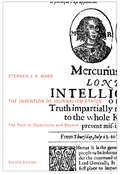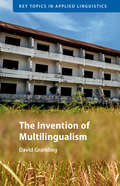- Table View
- List View
Inventing Sam Slick
by Richard A. DaviesThomas Chandler Haliburton (1796-1865) was one of pre-confederation Canada's best-known authors. His popular 'Sam Slick the Clockmaker' character was a household name not only in his home country, but also in England and the United States.Born in Windsor, Nova Scotia, Haliburton was not only a writer, but also a lawyer, judge, politician, and historian. He gained fame for his writing in 1836 with The Clockmaker: or, the Sayings and Doings of Samuel Slick of Slickville for a Halifax newspaper. It became a hit in England and was followed by six sequels. Although Haliburton tried to put Sam Slick aside and work in other genres, he found himself invariably returning to the character in his later books. This commitment to Slick resulted in a curious effacement of Haliburton's own personal gentlemanly identity, which he spent the second half of his life affirming by fostering links with socially well connected family in England. In the public imagination, however, he remained linked with Sam Slick. Based on over ten years of archival research, Richard A. Davies's scholarly biography of Haliburton is the first since 1924. It is an engaging examination of a controversial and contradictory Canadian writer and significant figure in the history of pre-confederation Nova Scotia.
Inventing the Alphabet: The Origins of Letters from Antiquity to the Present
by Johanna DruckerThe first comprehensive intellectual history of alphabet studies.Inventing the Alphabet provides the first account of two-and-a-half millennia of scholarship on the alphabet. Drawing on decades of research, Johanna Drucker dives into sometimes obscure and esoteric references, dispelling myths and identifying a pantheon of little-known scholars who contributed to our modern understandings of the alphabet, one of the most important inventions in human history. Beginning with Biblical tales and accounts from antiquity, Drucker traces the transmission of ancient Greek thinking about the alphabet’s origin and debates about how Moses learned to read. The book moves through the centuries, finishing with contemporary concepts of the letters in alpha-numeric code used for global communication systems. Along the way, we learn about magical and angelic alphabets, antique inscriptions on coins and artifacts, and the comparative tables of scripts that continue through the development of modern fields of archaeology and paleography. This is the first book to chronicle the story of the intellectual history through which the alphabet has been “invented” as an object of scholarship.
Inventing the Child: Culture (Children's Literature and Culture #Vol. 17)
by John ZornadoNow in paperback, Inventing the Child is a highly entertaining, humorous, and at times acerbic account of what it means to be a child (and a parent) in America at the dawn of the new millennium. J. Zornado explores the history and development of the concept of childhood, starting with the works of Calvin, Freud, and Rousseau and culminating with the modern 'consumer' childhood of Dr. Spock and television. The volume discusses major media depictions of childhood and examines the ways in which parents use different forms of media to swaddle, educate, and entertain their children. Zornado argues that the stories we tell our children contain the ideologies of the dominant culture - which, more often than not, promote 'happiness' at all costs, materialism as the way to happiness, and above all, obedience to the dominant order.
Inventing the Child: Culture, Ideology and the Story of the Child (Children's Literature And Culture Ser. #Vol. 17)
by Joseph L. ZornadoThis book traces the historical roots of Western culture's stories of childhood in which the child is subjugated to the adult. Going back 400 years, it looks again at Hamlet, fairy tales of the Brothers Grimm, and Walt Disney cartoons. Inventing the Child is a highly entertaining, humorous, and at times acerbic account of what it means to be a child (and a parent) in America at the dawn of the new millennium. John Zornado explores the history and development of the concept of childhood, starting with the works of Calvin, Freud, and Rousseau and culminating with the modern "consumer" childhood of Dr. Spock and television. The volume discusses major media depictions of childhood and examines the ways in which parents use different forms of media to swaddle, educate, and entertain their children. Zornado argues that the stories we tell our children contain the ideologies of the dominant culture--which, more often than not, promote "happiness" at all costs, materialism as the way to happiness, and above all, obedience to the dominant order.
Inventing the Critic in Renaissance England
by William M. RussellThe turn of the seventeenth century was an important moment in the history of English criticism. In a series of pioneering works of rhetoric and poetics, writers such as Philip Sidney, George Puttenham, and Ben Jonson laid the foundations of critical discourse in English, and the English word "critic" began, for the first time, to suggest expertise in literary judgment. Yet the conspicuously ambivalent attitude of these critics toward criticism—and the persistent fear that they would be misunderstood, marginalized, scapegoated, or otherwise "branded with the dignity of a critic"—suggests that the position of the critic in this period was uncertain. In Inventing the Critic in Renaissance England, William Russell reveals that the critics of the English Renaissance did not passively absorb their practice from Continental and classical sources but actively invented it in response to a confluence of social and intellectual factors.Distributed for UNIVERSITY OF DELAWARE PRESS
Inventing the Gothic Corpse: The Thrill Of Human Remains In The Eighteenth-century Novel
by Yael ShapiraInventing the Gothic Corpse shows how a series of bold experiments in eighteenth-century British realist and Gothic fiction transform the dead body from an instructive icon into a thrill device. For centuries, vivid images of the corpse were used to deliver a spiritual or political message; today they appear regularly in Gothic and horror stories as a source of macabre pleasure. Yael Shapira’s book tracks this change at it unfolds in eighteenth-century fiction, from the early novels of Aphra Behn and Daniel Defoe, through the groundbreaking mid-century works of Samuel Richardson, Henry Fielding and Horace Walpole, to the Gothic fictions of Ann Radcliffe, Matthew Lewis, Charlotte Dacre and Minerva Press authors Isabella Kelly and Mrs. Carver. In tracing this long historical arc, Shapira illuminates a hidden side of the history of the novel: the dead body, she shows, helps the fledgling literary form confront its own controversial ability to entertain. Her close scrutiny of fictional corpses across the long eighteenth century reveals how the dead body functions as a test of the novel’s intentions, a chance for novelists to declare their allegiances in the battle between the didactic and the “merely” pleasurable.
Inventing the Israelite
by Maurice SamuelsIn this book, Maurice Samuels brings to light little known works of literature produced from 1830 to 1870 by the first generation of Jews born as French citizens. These writers, Samuels asserts, used fiction as a laboratory to experiment with new forms of Jewish identity relevant to the modern world. In their stories and novels, they responded to the stereotypical depictions of Jews in French culture while creatively adapting the forms and genres of the French literary tradition. They also offered innovative solutions to the central dilemmas of Jewish modernity in the French context--including how to reconcile their identities as Jews with the universalizing demands of the French revolutionary tradition. While their solutions ranged from complete assimilation to a modern brand of orthodoxy, these writers collectively illustrate the creativity of a community in the face of unprecedented upheaval.
Inventing the It Girl: How Elinor Glyn Created The Modern Romance And Conquered Early Hollywood
by Hilary A. HallettA Publishers Weekly Summer Reads Selection The modern romance novel is elevated to a subject of serious study in this addictively readable biography of pioneering celebrity author Elinor Glyn. Unlike typical romances, which end with wedding bells, Elinor Glyn’s (1864–1943) story really began after her marriage up the social ladder and into the English gentry class in 1892. Born in the Channel Islands, Elinor Sutherland, like most Victorian women, aspired only to a good match. But when her husband, Clayton Glyn, gambled their fortune away, she turned to her pen and boldly challenged the era’s sexually straightjacketed literary code with her notorious succes de scandale, Three Weeks (1907). An intensely erotic tale about an unhappily married woman’s sexual education of her young lover, the novel got Glyn banished from high society but went on to sell millions, revealing a deep yearning for a fuller account of sexual passion than permitted by the British aristocracy or the Anglo-American literary establishment. In elegant prose, Hilary A. Hallett traces Glyn’s meteoric rise from a depressed society darling to a world-renowned celebrity author who consorted with world leaders from St. Petersburg to Cairo to New York. After reporting from the trenches during World War I, the author was lured by American movie producers from Paris to Los Angeles for her remarkable third act. Weaving together years of deep archival research, Hallett movingly conveys how Glyn, more than any other individual during the Roaring Twenties, crafted early Hollywood’s glamorous romantic aesthetic. She taught the screen’s greatest leading men to make love in ways that set audiences aflame, and coined the term “It Girl,” which turned actress Clara Bow into the symbol of the first sexual revolution. With Inventing the It Girl, Hallett has done nothing less than elevate the origins of the modern romance genre to a subject of serious study. In doing so, she has also reclaimed the enormous influence of one of Anglo-America’s most significant cultural tastemakers while revealing Glyn’s life to have been as sensational as any of the characters she created on the page or screen. The result is a groundbreaking portrait of a courageous icon of independence who encouraged future generations to chase their desires wherever they might lead.
Inventing the Language to Tell It: Robinson Jeffers and the Biology of Consciousness
by George HartFrom 1920 until his death in 1962, consciousness and its effect on the natural world was Robinson Jeffers’s obsession. Understanding and explaining the biological basis of mind is one of the towering challenges of modern science to this day, and Jeffers’s poetic experiment is an important contribution to American literary history—no other twentieth-century poet attempted such a thorough engagement with a crucial scientific problem. Jeffers invented a sacramental poetics that accommodates a modern scientific account of consciousness, thereby integrating an essentially religious sensibility with science in order to discover the sacramentality of natural process and reveal a divine cosmos.There is no other study of Jeffers or sacramental nature poetry like this one. It proposes that Jeffers’s sacramentalism emerged out of his scientifically informed understanding of material nature. Drawing on ecocriticism, religious studies, and neuroscience, Inventing the Languageto Tell It shows how Jeffers produced the most compelling sacramental nature poetry of the twentieth century.
Inventing the Modern Yiddish Stage: Essays in Drama, Performance, and Show Business
by Barbara Henry Joel BerkowitzCollects leading scholars' insight on the plays, production, music, audiences, and political and aesthetic concerns of modern Yiddish theater.
Inventing the New Negro
by Daphne LamotheIt is no coincidence, Daphne Lamothe writes, that so many black writers and intellectuals of the first half of the twentieth century either trained formally as ethnographers or worked as amateur collectors of folklore and folk culture. In Inventing the New Negro Lamothe explores the process by which key figures such as Zora Neale Hurston, Katherine Dunham, W. E. B. Du Bois, James Weldon Johnson, and Sterling Brown adapted ethnography and folklore in their narratives to create a cohesive, collective, and modern black identity.Lamothe explores how these figures assumed the roles of self-reflective translators and explicators of African American and African diasporic cultures to Western, largely white audiences. Lamothe argues that New Negro writers ultimately shifted the presuppositions of both literary modernism and modernist anthropology by making their narratives as much about ways of understanding as they were about any quest for objective knowledge. In critiquing the ethnographic framework within which they worked, they confronted the classist, racist, and cultural biases of the dominant society and challenged their readers to imagine a different set of relations between the powerful and the oppressed.Inventing the New Negro combines an intellectual history of one of the most important eras of African American letters with nuanced and original readings of seminal works of literature. It will be of interest not only to Harlem Renaissance scholars but to anyone who is interested in the intersections of culture, literature, folklore, and ethnography.
Inventing the Pinkertons; or, Spies, Sleuths, Mercenaries, and Thugs: Being a story of the nation’s most famous (and infamous) detective agency
by S. Paul O'HaraThe fascinating story of the most notorious detective agency in US history.Between 1865 and 1937, Pinkerton’s National Detective Agency was at the center of countless conflicts between capital and labor, bandits and railroads, and strikers and state power. Some believed that the detectives were protecting society from dangerous criminal conspiracies; others thought that armed Pinkertons were capital’s tool to crush worker dissent. Yet the image of the Pinkerton detective also inspired romantic and sensationalist novels, reflected shifting ideals of Victorian manhood, and embodied a particular kind of rough frontier justice. Inventing the Pinkertons examines the evolution of the agency as a pivotal institution in the cultural history of American monopoly capitalism. Historian S. Paul O’Hara intertwines political, social, and cultural history to reveal how Scottish-born founder Allan Pinkerton insinuated his way to power and influence as a purveyor of valuable (and often wildly wrong) intelligence in the Union cause. During Reconstruction, Pinkerton turned his agents into icons of law and order in the Wild West. Finally, he transformed his firm into a for-rent private army in the war of industry against labor. Having begun life as peddlers of information and guardians of mail bags, the Pinkertons became armed mercenaries, protecting scabs and corporate property from angry strikers.O’Hara argues that American capitalists used the Pinkertons to enforce new structures of economic and political order. Yet the infamy of the Pinkerton agent also gave critics and working communities a villain against which to frame their resistance to the new industrial order. Ultimately, Inventing the Pinkertons is a gripping look at how the histories of American capitalism, industrial folklore, and the nation-state converged.
Inventing the Popular: Printing, Politics, and Poetics (Routledge Studies in Nineteenth Century Literature)
by Bettina R. LernerInventing the Popular: Working-Class Literature and Culture in Nineteenth-Century France explores texts written, published and disseminated by a politically and socially active group of working-class writers during the first half of the nineteenth century. Through a network of exchanges featuring newspapers, poems and prose fiction, these writers embraced a vision of popular culture that represented a clear departure from more traditional oral and printed forms of popular expression; at the same time, their writing strategically resisted nascent forms of mass culture, including the daily press and the serial novel. Coming into writing at a time when Romanticism had expanded beyond the borders of the lyric je, these poets explored the social dimensions of connectivity and social relation finding interlocutors and supporters in the likes of Pierre-Jean de Béranger, Alphonse de Lamartine, George Sand and Eugène Sue. The relationships they developed among themselves and the major figures of an increasingly socially-oriented Romanticism were as rich with emancipatory promise as well as with reactionary temptation. They constitute an extensive archive of everyday life and utopian anticipation that reframe social romanticism as a revelatory if problematic model of engaged writing.
Inventing the Romantic Don Quixote in France: Jansenists, Rousseau, and British Quixotism (Routledge Studies in Latin American and Iberian Literature)
by Clark ColahanCervantes’ now mythical character of Don Quixote began as a far different figure than the altruistic righter of wrongs we know today. The transformation from mad highway robber to secular saint took place in the Romantic Era, but how and where it began has just begun to be understood. Germany and England played major roles, but, contrary to earlier literary historians, Pascal, Racine, Rousseau and the Jansenists scooped Henry and Sarah Fielding. Jansenism, a persecuted puritanical and intellectual movement linked to Pascal, identified itself with Don Quixote’s virtues, excused his vices, and wrote a game-changing sequel mediated by the transformative powers of a sorcerer from Commedia dell’Arte. As an early Romantic, Rousseau was attracted to the hero’s fertile imagination and tender love for Dulcinea, foregrounding the would-be knight’s quest in a play and his best-selling novel, Julie. Sarah Fielding reacted similarly, basing her utopian novel David Simple on the Jansenist concept of quixotic trust in others. Colahan here reproduces and explains for the first time the extremely rare original illustrations of the French sequel to Cervantes’ novel, and documents the fortunes in French culture of the magician at the heart of the Romantic Quixote.
Inventing the World Grant University: Chinese International Students’ Mobilities, Literacies, and Identities
by Steven Fraiberg Xiqiao Wang Xiaoye YouThrough an exploration of the literacy practices of undergraduate Chinese international students in the United States and China, Inventing the World Grant University demonstrates the ways in which literacies, mobilities, and transnational identities are constructed and enacted across institutional and geographic borders. Steven Fraiberg, Xiqiao Wang, and Xiaoye You develop a mobile literacies framework for studying undergraduate Chinese international students enrolling at Western institutions, whose numbers have increased in recent years. Focusing on the literacy practices of these students at Michigan State University and at Sinoway International Education Summer School in China, Fraiberg, Wang, and You draw on a range of mobile methods to map the travel of languages, identities, ideologies, pedagogies, literacies, and underground economies across continents. Case studies of administrators’, teachers’, and students’ everyday literacy practices provide insight into the material and social structures shaping and shaped by a globalizing educational landscape. Advocating an expansion of focus from translingualism to transliteracy and from single-site analyses to multi-site approaches, this volume situates local classroom practices in the context of the world grant university. Inventing the World Grant University contributes to scholarship in mobility, literacy, spatial theory, transnationalism, and disciplinary enculturation. It further offers insight into the opportunities and challenges of enacting culturally relevant pedagogies.
Inventing Tomorrow: H. G. Wells and the Twentieth Century
by Sarah ColeH. G. Wells played a central role in defining the intellectual, political, and literary character of the twentieth century. A prolific literary innovator, he coined such concepts as “time machine,” “war of the worlds,” and “atomic bomb,” exerting vast influence on popular ideas of time and futurity, progress and decline, and humanity’s place in the universe. Wells was a public intellectual with a worldwide readership. He met with world leaders, including Roosevelt, Lenin, Stalin, and Churchill, and his books were international best-sellers. Yet critics and scholars have largely forgotten his accomplishments or relegated them to genre fiction, overlooking their breadth and diversity.In Inventing Tomorrow, Sarah Cole provides a definitive account of Wells’s work and ideas. She contends that Wells casts new light on modernism and its values: on topics from warfare to science to time, his work resonates both thematically and aesthetically with some of the most ambitious modernists. At the same time, unlike many modernists, Wells believed that literature had a pressing place in public life, and his works reached a wide range of readers. While recognizing Wells’s limitations, Cole offers a new account of his distinctive style as well as his interventions into social and political thought. She illuminates how Wells embodies twentieth-century literature at its most expansive and engaged. An ambitious rethinking of Wells as both writer and thinker, Inventing Tomorrow suggests that he offers a timely model for literature’s moral responsibility to imagine a better global future.
Inventing The Truth: The Art and Craft of Memoir
by Annie Dillard Alfred Kazin William ZinsserFor anyone who enjoys reading memoirs??—??or is thinking about writing one??—??this collection offers a master class from nine distinguished authors, including Annie Dillard, Frank McCourt, and others. The events, memories, and emotions of the past often resist the orderly structure of a book. Inventing the Truth offers wisdom from nine notable memoirists about their process (Ian Frazier searched through generations of family papers to understand his parents' lives), the hurdles they faced (Annie Dillard tackles the central dilemma of memoir: what to put in and what to leave out), and the unexpected joys of bringing their pasts to the page. Featured authors include Russell Baker on Growing Up; Jill Ker Conway on The Road from Coorain; Annie Dillard on An American Childhood; Ian Frazier on Family; Henry Louis Gates Jr. on Colored People; Alfred Kazin on A Walker in the City; Frank McCourt on Angela's Ashes; Toni Morrison on Beloved; and Eileen Simpson on Poets in Their Youth.
Inventing William of Norwich: Thomas of Monmouth, Antisemitism, and Literary Culture, 1150–1200 (The Middle Ages Series)
by Heather BlurtonWilliam of Norwich is the name of a young boy purported to have been killed by Jews in or about 1144, thus becoming the victim of the first recorded case of such a ritual murder in Western Europe and a seminal figure in the long history of antisemitism. His story is first told in Thomas of Monmouth's The Life and Miracles of William of Norwich, a work that elaborates the bizarre allegation, invented in twelfth-century England, that Jews kidnapped Christian children and murdered them in memory and mockery of the crucifixion of Christ.In Inventing William of Norwich Heather Blurton resituates Thomas's account by offering the first full analysis of it as a specifically literary work. The second half of the twelfth century was a time of great literary innovation encompassing an efflorescence of saints' lives and historiography, as well as the emergence of vernacular romance, Blurton observes. She examines The Life and Miracles within the framework of these new textual developments and alongside innovations in liturgical and devotional practices to argue that the origin of the ritual murder accusation is imbricated as much in literary culture as it is in the realities of Christian-Jewish relations or the emergence of racially based discourses of antisemitism. Resisting the urge to interpret this first narrative of the blood libel with the hindsight knowledge of later developments, she considers only the period from about 1150-1200. In so doing, Blurton redirects critical attention away from the social and economic history of the ritual murder accusation to the textual genres and tastes that shaped its forms and themes and provided its immediate context of reception. Thomas of Monmouth's narrative in particular, and the ritual murder accusation more generally, were strongly shaped by literary convention.
The Invention and Gendering of Epicurus
by Pamela GordonThe school of Greek philosopher Epicurus, which became known as the Garden, famously put great stock in happiness and pleasure. As a philosophical community, and a way of seeing the world, Epicureanism had a centuries-long life in Athens and Rome, as well as across the Mediterranean. The Invention and Gendering of Epicurusstudies how the Garden's outlook on pleasure captured Greek and Roman imaginations---particularly among non-Epicureans---for generations after its legendary founding. Unsympathetic sources from disparate eras generally focus not on historic personages but on the symbolic Epicurean. And yet the traditions of this imagined Garden, with its disreputable women and unmanly men, give us intermittent glimpses of historical Epicureans and their conceptions of the Epicurean life. Pamela Gordon suggests how a close hearing and contextualization of anti-Epicurean discourse leads us to a better understanding of the cultural history of Epicureanism. Her primary focus is on sources hostile to the Garden, but her Epicurean-friendly perspective is apparent throughout. Her engagement with ancient anti-Epicurean texts makes more palpable their impact on modern responses to the Garden. Intended both for students and for scholars of Epicureanism and its response, the volume is organized primarily according to the themes common among Epicurus' detractors. It considers the place of women in Epicurean circles, as well as the role of Epicurean philosophy in Homer and other writers.
The Invention of China in Early Modern England: Spelling the Dragon (Early Modern Literature in History)
by Jonathan E. LuxThe Invention of China in Early Modern England describes how several different English communities became aware of China. It begins by describing how early modern intellectuals used the utopian ideal of China to license all kinds of progressive innovation before chronicling how England’s growing commerce in southeast Asia radically changed China’s representation in the English discourse community. For the new community of English merchants proposing to trade in Chinese goods, China became the seminal example in the growing discourse community of English Orientalism. It was an absolute or arbitrary authoritarian state, associated with crooked business dealings, and cloaked in a rhetoric of secrecy and exclusion—a dangerous exception to the traditions, values, and identities of the emergent English speaking states. Finally, the book points out some of the ways that contemporary English language sources continue to represent this early modern English thought tradition, labelling the complexities of modern China with analytical vocabulary perhaps better suited to the pressing political anxieties of the seventeenth century.
The Invention of English Criticism
by Michael GavinEarly literary criticism was undisciplined. Unlike the staid essays and monographs of later academic scholarship, English criticism first appeared in the contentious world of the London theater: dramatists and other poets argued about their craft in contending prefaces and dedications, and their disputes spilled into the public sphere in pamphlet wars, mock epics, lampoons, and even novels. Across these forms, criticism was personal, political, and unconcerned with analysis for its own sake. Yet this unruly discourse laid the groundwork both for modern literary criticism and for the discipline of literary studies. The Invention of English Criticism explores the earliest uses of criticism and the attempts by some to convert a field of literary debate into an archive of useful knowledge. Criticism's undisciplined past thus illuminates its contested, ambivalent, and never fully disciplined present.
The Invention of Female Biography (Chawton Studies in Scholarly Editing)
by Gina Luria WalkerMary Hays worked alone in compiling the 302 entries that make up Female Biography (1803). By contrast, producing a modern, critical edition of the work relied on the expertise of 168 scholars across 18 countries. Essays in this collection focus on the exhaustive research, editorial challenges and innovative responses involved in this project.
The Invention of Journalism Ethics, Second Edition
by Stephen J.A. WardDoes objectivity exist in the news media? In The Invention of Journalism Ethics, Stephen Ward argues that given the current emphasis on interpretation, analysis, and perspective, journalists and the public need a new theory of objectivity. He explores the varied ethical assertions of journalists over the past few centuries, focusing on the changing relationship between journalist and audience. This historical analysis leads to an innovative theory of pragmatic objectivity that enables journalists and the public to recognize and avoid biased and unbalanced reporting. Ward convincingly demonstrates that journalistic objectivity is not a set of absolute standards but the same fallible but reasonable objectivity used for making decisions in other professions and public institutions. Considered a classic in the field since its first publication in 2004, this second edition includes new chapters that bring the book up to speed with journalism ethics in the twenty-first century by focusing on the growing dominance of online journalism and calling for a radical approach to journalism ethics reform. Ward also addresses important developments that have occurred in the last decade, including the emergence of digital journalism ethics and global journalism ethics.
The Invention of Journalism Ethics, Second Edition: The Path to Objectivity and Beyond (McGill-Queen's Studies in the History of Ideas #107)
by Stephen J.A. WardDoes objectivity exist in the news media? In The Invention of Journalism Ethics, Stephen Ward argues that given the current emphasis on interpretation, analysis, and perspective, journalists and the public need a new theory of objectivity. He explores the varied ethical assertions of journalists over the past few centuries, focusing on the changing relationship between journalist and audience. This historical analysis leads to an innovative theory of pragmatic objectivity that enables journalists and the public to recognize and avoid biased and unbalanced reporting. Ward convincingly demonstrates that journalistic objectivity is not a set of absolute standards but the same fallible but reasonable objectivity used for making decisions in other professions and public institutions. Considered a classic in the field since its first publication in 2004, this second edition includes new chapters that bring the book up to speed with journalism ethics in the twenty-first century by focusing on the growing dominance of online journalism and calling for a radical approach to journalism ethics reform. Ward also addresses important developments that have occurred in the last decade, including the emergence of digital journalism ethics and global journalism ethics.
The Invention of Multilingualism (Key Topics in Applied Linguistics)
by David GramlingMultilingualism is a meaningful and capacious idea about human meaning-making practice, one with a promising, tumultuous, and flawed present - and a future worth caring for in research and public life. In this book, David Gramling presents original new insights into the topical subject of multilingualism, describing its powerful social, economic and political discourses. On one hand, it is under acute pressure to bear the demands of new global supply-chains, profit margins, and supranational unions, and on the other it is under pressure to make way for what some consider to be better descriptors of linguistic practice, such as translanguaging. The book shows how multilingualism is usefully able to encompass complex, divergent, and sometimes opposing experiences and ideas, in a wide array of planetary contexts - fictitious and real, political and social, North and South, colonial and decolonial, individual and collective, oppressive and liberatory, embodied and prosthetic, present and past.
